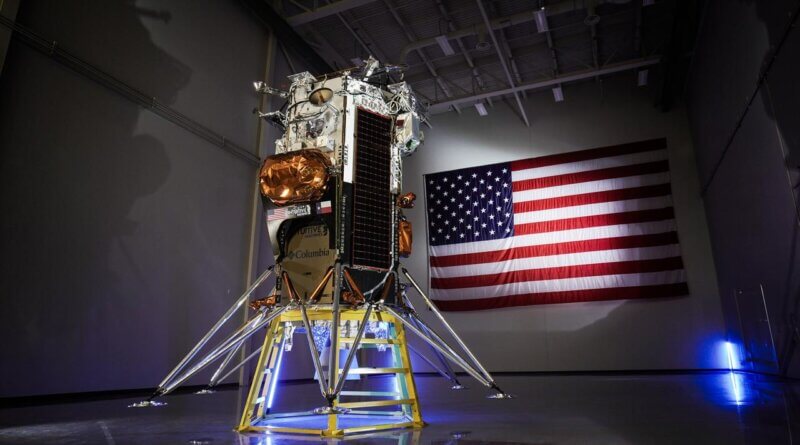Space Is The Place: The Night Sky Over Belper, March 2024
The Night Sky Over Belper: US Moon Mission, Comet Pons-Brooks, Star Count Survey, The Vernal Equinox, British Summer Time begins.
IM-1 Odysseus Lands On The Moon
On the 22nd of February the United States landed a spacecraft on the Moon. The Moon Lander, IM-1 Odysseus, is part of NASA’s Commercial Lunar Payload Services (CLPS) programme and is notable for being the first private sector built spacecraft to land on the Moon. The company that built Odysseus, Intuitive Machines, will be working in partnership with NASA to send more missions to the Moon later this year, one to drill into the lunar surface and another to explore surface conditions.
Odysseus had a difficult landing (similar to the Japanese SLIM Lander in January). However, it was still able to send back information and the mission was regarded as successful by NASA and Intuitive Machines. More detail and images here: IM-1 Intuitive Machines website. (Headline Image: IM-1 Lander, courtesy of NASA Images).
The Vernal Equinox: March 20th
The Vernal Equinox takes place on Wednesday 20th of March. The Vernal Equinox is regarded as the start of astronomical spring in the northern hemisphere, although meteorologists consider March the 1st as the relevant date. The Vernal Equinox is also the time of the year when the Sun will rise due east and set due west (thus determining these cardinal points of the compass in your location).
British Summer Time: 31st March
British Summer Time starts on Sunday the 31st of March and clocks go forward an hour in the UK. Most astronomy sites record times in UTC (Co-ordinated Universal Time) equivalent to Greenwich Mean Time (GMT). UK Astronomers have to be mindful that, after the 31st, they will need to add an hour where times have not been converted: BST = UTC + 1.
Star Count 2024 – Notes
The CPRE star count survey did not take place this year (see last month’s Space Is The Place). Instead I did my own star count from the back garden in Belper.
The star count is designed as a simple measure of light pollution in your area. In a dark site sky you should see around 30 stars within the constellation of Orion (with the naked eye). In a poor sky you might only see Orion’s belt (3 stars) and a few others. The CPRE regards anything below 10 stars as an indication of severe light pollution.
When I was able to make my observation I counted 14 stars (including Orion’s Belt). The Belper garden is surrounded by other houses and the results for 2024 are consistent with previous year’s results. I know from experience that it is hard to see fuzzy objects (galaxies, comets, etc.) from there. As such, it has proven useful to have portable equipment (in my case a small telescope, a light tripod, and binoculars) to enable viewing from darker sites.
The Moon
13th – 16th March: A waxing crescent Moon appears near to Jupiter, the Pleiades and the red star Alderbaran over the course of these nights. Look towards the west.
25th March: Full Moon
The Planets
Jupiter dominates the early evening sky, shining brightly in the west. Binoculars will show its moons. A telescope will show planetary detail (e.g. cloud bands). Jupiter will appear close to the crescent Moon on the 13th.
Comet 12p / Pons-Brooks
This comet is currently in the constellation of Andromeda (8th / 9th of March). At the moment it is faint and not visible to the naked eye, but it could be worth trying to find with binoculars, see tracker info here: Sky Live.
The comet is expected to brighten over the coming months. There is a good summary of what to expect here: Comet Section – Society of Popular Astronomy.
The International Space Station
The International Space Station is one of the brightest objects in the night sky. It is not hard to spot and flies-past periodically throughout the year. Fly-pasts tend to swing from PM to AM.
Typically the ISS will be in the sky for up to four minutes at a time – slowly moving across the sky, at first bright and then fading as it moves away from us and over the horizon.
NASA’s Spot the Station service gives the time, duration and direction of sightings. Note that the ISS arrives on time: it is best to be in position around 5 minutes before the predicted sighting – otherwise you may miss seeing it. You can also use a mobile app – which gives alerts for the more prominent sightings.

